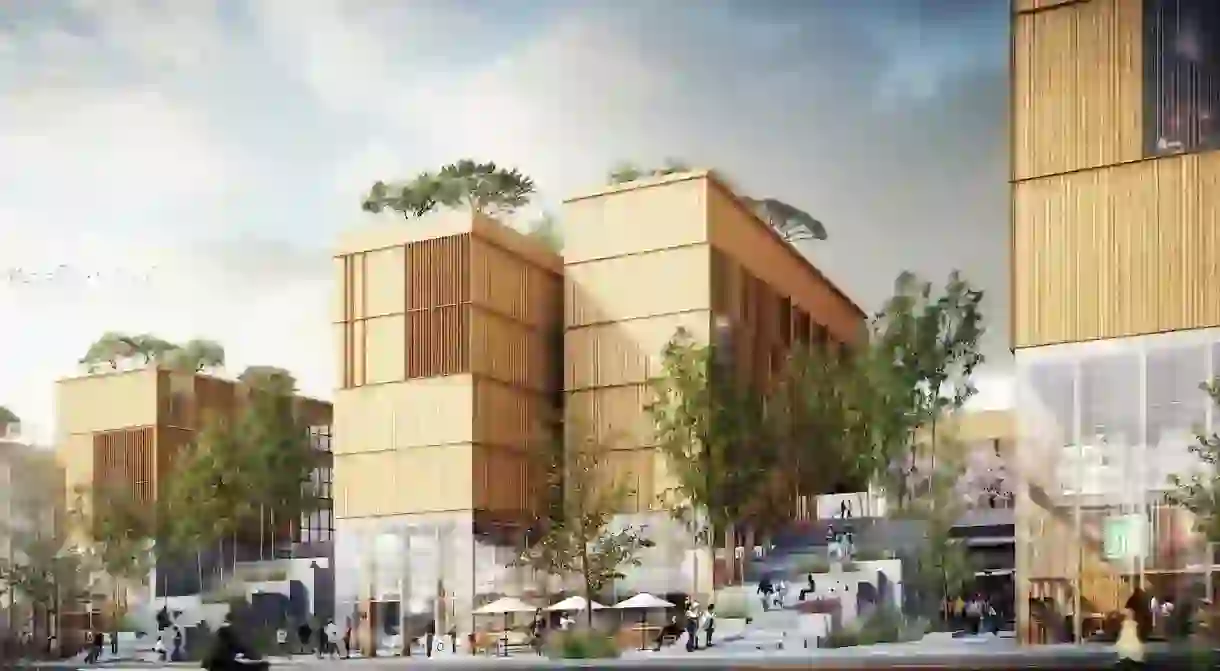Timber Rising: How Architects Across the World Are Revolutionising the Skyscraper

Almost without fail, at the heart of any major city, you’ll be surrounded by a forest of sky-high glass, steel and concrete buildings. It often feels cold, impersonal and perhaps even a bit lonely. But what if the concrete jungle started to feel more like an actual woodland? While architects dislike the term ‘trend’, there is undoubtedly a revolution happening in the architecture industry, where practices are turning towards timber for a more sustainable, efficient and healthier high-rise alternative.
Timber Rising at the Roca London Gallery is the first exhibition to truly showcase the importance of these innovative high-rise structures that are currently being built across the world, especially when C0² levels are the highest they’ve ever been in 800,000 years and we’re facing a global crisis in the form of high-density cities, housing shortages, climate change and also increasing pressures on our wellbeing.

While your immediate response might be to question the use of timber as a sustainable source – there’s global deforestation to consider, of course – it’s a far better alternative to our current conventional building materials, providing the wood is sustainably harvested. For a start, building with timber uses far less energy during the construction process, plus mass timber actually absorbs CO² in an amazing way and has a much smaller carbon footprint than its concrete and steel counterparts. The huge wooden panels and modular designs can also be prefabricated off-site, which offers great possibilities for construction in the future – sustainable housing can be built at a much quicker rate, at a lower cost and more efficiently, providing the accommodation that is so desperately needed in the heaving cities across the globe.

There’s also a reason why Tudor buildings, for example, are still standing strong – wood is a highly durable material with good structural properties and, perhaps surprisingly, it’s actually more resistant than some metals – it burns in a more predictable way compared to steel, which dramatically collapses when it reaches the ‘flash point’.
Architect Michael Green of Vancouver-based practice MGA, whose work is featured in the Timber Rising exhibition, said: ‘I always say that the hardest job is not the engineering or science behind how these mass timber buildings are constructed, but it’s changing the public’s perception of what is possible and why. This exhibition will help to change that, to enlighten, and help people to understand the issues.’

It’s not just that timber has plenty of superior structural qualities and ecological benefits – it’s also about creating a future environment that can actually improve mental wellbeing and provide users with better spaces to live and work in. Research has actually shown that the use of these engineered timber products can benefit our own health as well as our surroundings, offering a tactile beauty, warmth and even scent. The exhibition investigates the kind of impact these new timber developments can have on our future environment and urban health, including theories on ‘biophilia’, which suggests human beings desire a closer connection to natural materials.
‘A CLT (cross-laminated timber) structure is a beautiful environment to live in. There’s something intangibly different about it. It’s calmer, more serene, and you sleep better. It feels like it shapes itself around you,’ says architect Andrew Waugh, of London-based firm Waugh Thistleton.

Timber Rising will showcase some of the most significant mass timber solutions that have been built so far, as well as some truly ambitious concepts and research proposals that aim to push the boundaries of what’s currently possible. Key projects on display in the exhibition include Waugh Thistleton’s Dalston Lane 10-storey development in Hackney, which is currently the world’s largest CLT building, and Treet (The Tree), Artec’s 14-storey modular timber-framed apartment block in Norway. There’s also Lagos’ Wooden Tower concept by Hermann Kamte & Associates, which will see an existing housing estate transformed by a rising timber design with sky gardens, plus the impressive 80-storey Oakwood Timber Tower concept for the Barbican by London-based firm PLP, which has worked closely with Cambridge University’s architecture department to propose a design based on utilising the lightness of engineered timber (much like carbon fibre), to build on top of existing urban structures.

Curators Clare Farrow and Eva Woode said: ‘We are delighted to be presenting the first comprehensive exhibition of tall timber buildings, here in the UK, which will examine the historical context for this new phenomenon in architecture, and will also look at our intimate connection to wood – an ancient material that has now become the most modern, and which in its engineered form seems to offer as much to humanity as it does to the environment. As Alvar Aalto said, wood is the most “deeply human” of all materials.’

Who knows what the cities of tomorrow will look like, but change is certainly in the air – while this exhibition is a small step forward in raising awareness for the possibilities of cutting-edge timber construction, it demonstrates just how important and impactful these innovations could be for our future urban landscapes.
Timber Rising will run from February 9–May 19, 2018 at the Zaha Hadid-designed Roca London Gallery, Station Court, Townmead Road, London SW6 2PY. Free entry.













